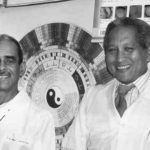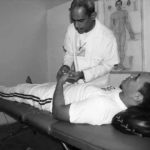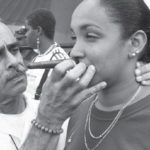 Since 1995, the Cuban Sports Medicine Institute has integrated natural and traditional medicine (NTM, also known in the United States as Complementary and Alternative Medicine or CAM) into its array of prevention techniques and rehabilitation therapies for Cuban athletes. Incorporating NTM into conventional medical practice- both for the Institute and the public health system as a whole-has been a sometimes prickly process, confronting prejudice among some in the medical profession and among patients themselves.
Since 1995, the Cuban Sports Medicine Institute has integrated natural and traditional medicine (NTM, also known in the United States as Complementary and Alternative Medicine or CAM) into its array of prevention techniques and rehabilitation therapies for Cuban athletes. Incorporating NTM into conventional medical practice- both for the Institute and the public health system as a whole-has been a sometimes prickly process, confronting prejudice among some in the medical profession and among patients themselves.
The Sports Medicine Institute’s NTM Unit is headed by medical director Anisio León and technical director Pedro Carmona, who spoke with MEDICC Review about the history, philosophy, results and challenges of their work.
MEDICC Review: How would you describe your unit and its role at the Sports Medicine Institute?
Pedro Carmona: Our unit is part of the Institute’s Physical Therapy Department, where physicians, physical therapists and technicians combine their training in Western medicine and NTM to create a more integrated approach. We respect the diagnostic methods of both types of medicine and combine therapeutic techniques according to each patient’s characteristics. In order of priority, our mission is to provide services to active athletes, retired athletes and their families, Institute staff, and residents of the surrounding community. We see about 150 patients a week.
Anisio León: The Institute assigns what we call a triad-a doctor, physical therapist and psychologist-to each national athletic team. This triad provides primary sports medicine care. At the NTM unit, we tend to function as a second level of care. We see neurological pathologies, lumbosacral lesions, knee and ankle injuries, and so forth. But we also do prevention and health promotion. We use traditional Oriental medicine, homeopathy, aromatherapy and Western medicine. As Pedro mentioned, the options range from exclusive treatment with NTM or Western medicine to a combination of the two. The important thing is that NTM is not divorced from Western medicine. On the contrary, the two work in harmony.
Our team is small but efficient. Pedro, our technical director, has training in NTM. He is joined by two physical therapists and one adjunct team member with a master’s degree in NTM. I am the medical director, hold a master’s degree in NTM, and have received additional training at the Beijing University of Traditional Medicine in China. MEDICC Review: What prompted creation of the NTM Unit at the Institute?
Pedro Carmona: To understand NTM at the Institute you have to understand the historical and social context of NTM in Cuba itself. Over the years, there had been contacts with NTM from Oriental medical tradition, but these were sporadic encounters, isolated seminars and workshops. This type of medicine at the time was truly alternative-outside conventional medical practice. Then in the 1980s, therapists from China, Vietnam and the Korean peninsula started visiting Cuba to offer seminars and work more systematically with healthcare professionals.
In the early 1990s, the disintegration of the socialist bloc meant the loss of our main trading partners, and plunged the country into serious economic crisis. This prompted health officials to search for ways to maximize resources. NTM presented several less costly options. This and NTM practices already developed among some health professionals and the general population helped move the country towards broader adoption of NTM within the public health system.
Anisio León: We inherited some traditional medicine as folk medicine from our Spanish and African ancestors, especially the use of plants and herbal teas. Later came the influence of Chinese immigrants who arrived in Cuba in the mid-1800s. In fact, Chinese doctors were practicing acupuncture here since the War of Independence at the end of the 19th century. However, NTM was not systematically introduced into the national health system until it was adopted by the Ministry of Public Health in the early 1990s. Since then, it is part of standard clinical practice and medical education. Post-graduate degrees and residencies in NTM are offered by Cuban medical schools, and physicians also travel to Asia for post-graduate study. So NTM is no longer an alternative medicine, but rather part and parcel of Cuban medicine.
In this context, the Sports Medicine Institute’s adoption of NTM in 1995 was a natural progression of the national initiative to integrate NTM seamlessly with conventional medicine throughout the Cuban health system.
MEDICC Review: Tell us more about your work with athletes.
Anisio León: In the area of prevention and health promotion, we seek to stimulate and maximize athletes’ inherent abilities-to help them be in the best possible condition. For example, we use traditional Oriental therapeutic exercises such as Qigong and Tai chi chuan to strengthen athletes’ immune system.
Pedro Carmona: Another example of prevention is our experience with the Cuban gymnastics team. When I started working as the team’s physical therapist in 1997, the gymnasts were presenting a level of training injuries similar to that of combat sports such as taekwondo or boxing. Through the application of traditional Oriental exercises and techniques, the number of injuries declined substantially.
Our main area of work is rehabilitation. Sometimes we see patients for whom other therapies have failed. More often, though, physical therapists and sports doctors send us athletes for combined therapies for routine injuries. In addition to treatments provided here in our unit, we go to athletes’ training areas and, of course, accompany teams to competitions. I’m now the physical therapist for the national foil fencing team, so I provide treatments wherever the athletes are, and also work with athletes and physical therapists in other sports.
MEDICC Review: What type of treatments and/or therapies do you use?
Pedro Carmona: We use some 60 different techniques. The ones we use almost on a daily basis are acupuncture, manipulative and massage therapies, moxibustion, and traditional Oriental therapeutic exercises.
Anisio León: Acupuncture is one of the techniques we use most often, including sub-types such electroacupuncture and acupressure. An important form of acupressure is eciwo, which means “embryo” in Chinese and refers to using a part of the body as a microsystem in which the whole body is reflected. There are 21 microsystems described, including the ear, tongue, second metacarpal, and forearm. We’ve been doing a lot of work on the second metacarpal and the forearm, since it is easiest for patients to learn to self-apply acupressure in these areas.
We also use moxibustion-applying heat from burning cigar-like rolls of mugwort (Artemisia vulgaris) to acupoints. Within Chinese traditional medicine, these are used for “cold illnesses,” such as muscle spasms and lumbago. Manipulative therapy is an umbrella term that refers to chiropractic and osteopathic practices, and traditional Oriental massage, which includes pressing, rubbing and moving muscles and other soft tissue, such as you find in Shiatsu and Seitai from Japan.
Finally, we use traditional preventive and therapeutic Oriental exercises, such as Qigong from China, which involves movement, controlled breathing and meditation.
MEDICC Review: Traditional Oriental medicine also views the patient somewhat differently than Western medicine. What does that mean for your work?
Pedro Carmona: The practice of NTM is embedded in a set of complex philosophies; it is impossible to practice NTM without considering what the Chinese call the Qi, the life force, or what the Japanese call Kokoro, the force of the heart, which encompasses concentration and visualization. So, we don’t separate the mind from the body. Of course, since we are also trained in Western medicine, we understand that as Western medicine advanced it became highly specialized. The psychiatrist and the psychologist concentrate on the brain and the mind, the orthopedist on the musculoskeletal system, the endocrinologist on metabolic processes, and so on. But we see the whole person. Western medicine is the medicine of parts while NTM is a holistic medicine. We recognize that each type of medicine emerges from a different frame of reference, offering practitioners a different and unique set of lenses to explain body processes, health and illness. Each type of medicine offers a set of tools based on its own framework.
 Chinese medicine is an ancient tradition dating back over 2000 years with an ample set of practices based on healing theories. It has also influenced medicine systems of other countries in Asia which took off and developed into independent local traditions. Our unit has adopted elements from different traditions in Vietnam, the Korean peninsula, Japan and, to a lesser extent, India. These systems do tend to place much more emphasis on the practitioner-patient relationship than Western medicine, the patient’s idiosyncrasies, and his or her context are all very important to the NTM practitioner. Special attention is also given to time, seasonality and place.
Chinese medicine is an ancient tradition dating back over 2000 years with an ample set of practices based on healing theories. It has also influenced medicine systems of other countries in Asia which took off and developed into independent local traditions. Our unit has adopted elements from different traditions in Vietnam, the Korean peninsula, Japan and, to a lesser extent, India. These systems do tend to place much more emphasis on the practitioner-patient relationship than Western medicine, the patient’s idiosyncrasies, and his or her context are all very important to the NTM practitioner. Special attention is also given to time, seasonality and place.
Anisio León: One of my main interests is this relationship of time and seasonality to health-and-illness processes. I’ve been practicing chrono-acupuncture, based on the more general field of chronobiology, which studies the biological rhythms of organisms and trends in the timing of biological events. For example, some illnesses are more common at certain hours. Chrono-pharmacology applies chronobiology to improve the effectiveness of medications if given at certain times of the day. Chronoacupuncture applies acupuncture at an optimal moment during 10-hour cycles, and we’re also working on chronomassage. Ultimately, by maximizing our knowledge of biological rhythms applied to the timing of therapeutic applications, we seek to achieve better outcomes in fewer sessions. This aim is very important since athletes are always working within tight timelines.
MEDICC Review: You mentioned that you work with community residents as well.
Anisio León: Since 2003, we’ve been involved in a project we call the “school of bioenergy exercises”. It’s an open school-withoutwalls, in the sense that we use open spaces on the Institute grounds or in the community, and anyone, including athletes and retired athletes, can participate. People of all ages and from all walks of life join in the sessions we hold three mornings a week. In wintertime, about 60 people come, and in summertime we get close to 100.
The school also offers classes and workshops on various topics. Popular classes include Twenty Exercises for Longevity, in which we teach both the why and the how-to of exercises to promote a self-help model of care. The classes on acupressure, selfmassage for bone-and-joint problems, and use of medicinal plants have also been very well attended. Other topics include use of antioxidants, laughter therapy and Feng Shui.
MEDICC Review: NTM is a topic that seems to spark a range of opinions from uncritical enthusiasm to skepticism and outright rejection. What kinds of challenges have you faced in your NTM practice?
Anisio León: We’ve certainly experienced skepticism, and we recognize that research is fundamental to overcoming it. Most skeptics question the scientific bases of NTM. In our unit, we understand the need to apply the scientific method to prove the efficacy and effectiveness of NTM therapies. One opportunity for this is provided by the research carried out under our guidance for master’s degree theses in NTM. These studies, while still based on relatively small samples, help create a culture of research among our recent graduates. They also serve as pilot studies that can be expanded.
One such study evaluated the effects of practicing traditional Oriental exercises by older adults. Seventy-four participants in the traditional Oriental exercise program at our school of bioenergy exercises, whose average age was 65 years, were surveyed three and six months after participating in the program for at least a year. The aim was to assess changes in prescribed medication, chronic disease management and quality of life. The study found that 12% of those surveyed stopped taking medications for a chronic condition, because they no longer needed them, and 52% reduced their medication intake. Similarly, 33% showed an improvement on the quality-of-life scale. Now we’re proposing a research project to evaluate a detraining program for retiring athletes based on a set of traditional Oriental exercises. The goal of detraining is to maintain a high quality of life and the benefits of exercise in individuals whose level of physical activity is substantially reduced after retirement.
Pedro Carmona: We know that the more scientific evidence there is, the more NTM practice will grow. In the meantime, results in individual athletes and teams also ease the initial skepticism when people are faced with what they at first consider unorthodox practice.
For example, athletes in speed sports like track-and-field are often incredulous when we ask them to engage in the practice of very slow exercise, where the goal is to be as still as possible. This entirely contradicts the very nature of their sport, but when they saw their concentration and overall sense of well-being improve, these athletes became more receptive.
 Applying pressure on runner’s governing vessel 26 at the Terry Fox Marathon in Havana.
Applying pressure on runner’s governing vessel 26 at the Terry Fox Marathon in Havana.
In fact, most of the skeptics have been slowly coming around. For example, about ten years ago, we started using a technique at the finish line of marathons that involves applying pressure on the area immediately above the upper lip (known as governing vessel 26) to prevent collapse at the end of the race, helping runners recover almost instantaneously. At the time, track-and-field coaches were very skeptical, but they became convinced when they saw athletes free of the uncomfortable fainting spells that can overcome them at the finish line. Now, at mass-participation marathons, the sight of NTM practitioners pressing a wooden pointer on the upper lip of athletes at the race’s end has become quite normal.






